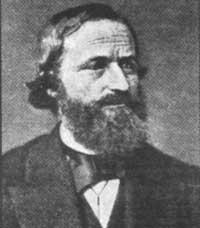Physicist G. Robert Kirchhoff
Kirchhoff studied at the University of Königsberg and did interesting work on the theory of electricity. The electric current, for example, moved by the speed of light before anyone else.
His fame spread when in 1854 he was appointed professor of physics at Heidelberg. There R. He met Wilhelm Bunsen. He cared about Buns photochemistry, researching the light that had passed in the color filters. Kirchhoff had Newton's influence and mathematical training. That is why Bunsen recommended to use the prism when investigating the light, and both, projecting the light through a groove to the prism, got the same spectroscope. The wavelengths of the light were refracted differently and different images in the slot obtained different spectra.
The use of the Bunsen lighter was also beneficial. The light of the lighter was weak and did not generate luminous funds. In this way it was not mixed with the light he was studying or with the light of the heated minerals to its maximum splendor.

Using the spectroscope, Kirchhoff realized that each chemical element, when heated, left certain color lines. For example, incandescent sodium vapor leaves a double yellow line. Somehow, each element leaves its fingerprints on the spectroscope and thus you could know if it was formed by any mineral or element.
By 1859 this system of recognition of the composition of the materials had spread, finding with spectroscope new chemical elements until then unknown. For example, Kirchhoff discovered cesium and rubidium in 1860 and 1861 respectively.
Kirchhoff went further with his spectroscope. He found that the double bright line left by sodium was equal to the D-line represented by Fraunhofer on the solar spectrum. He also conducted other ancillary tests and concluded that sunlight passed through sodium vapor. So in the Sun there was sodium. He also identified dozens of other elements.
In his spectroscopic research he demonstrated: When the light passes through a gas, it absorbs the wavelengths that the gas itself would have at its highest point. This phenomenon is often referred to as the “Kirchhoff law.”
Subsequently, spectroscopy also took another path. And it is that through the spectroscope began to study the wide Universe and the interior of the tiny atoms.
Physicist Kirchhoff also tried to study the black body. The black body absorbs the radiations of all wavelengths that reach it. Thus, Kirchhoff claimed that once the black body became incandescent it would emit all wavelengths.
To get a black body, Kirchhoff suggested building a box with black walls inside and a small hole in a face. Thus, the radiation introduced through the hole could hardly come out again. If by means of radiations the box perfectly was placed above, by a hole all wavelengths would come out.
Black body research was of great importance for the subsequent publication of quantum theory by Max Planck.
Physicist Kirchhoff died in Berlin on 17 October 1887.
Buletina
Bidali zure helbide elektronikoa eta jaso asteroko buletina zure sarrera-ontzian











